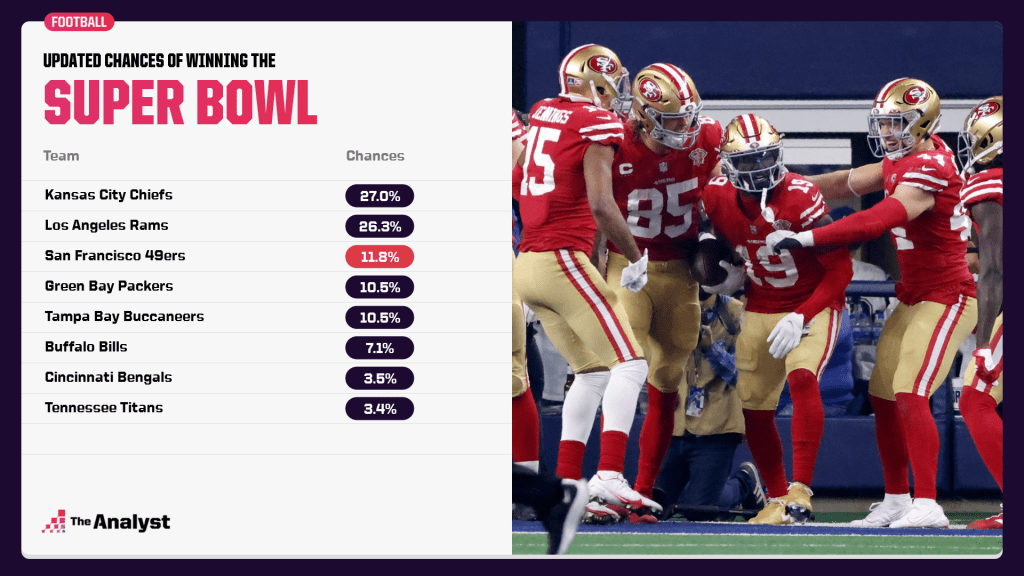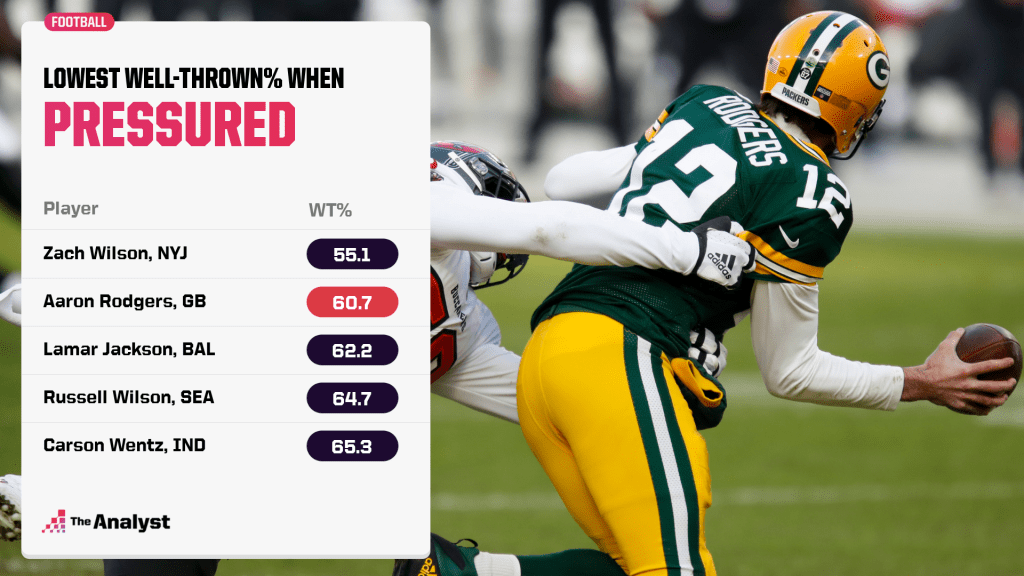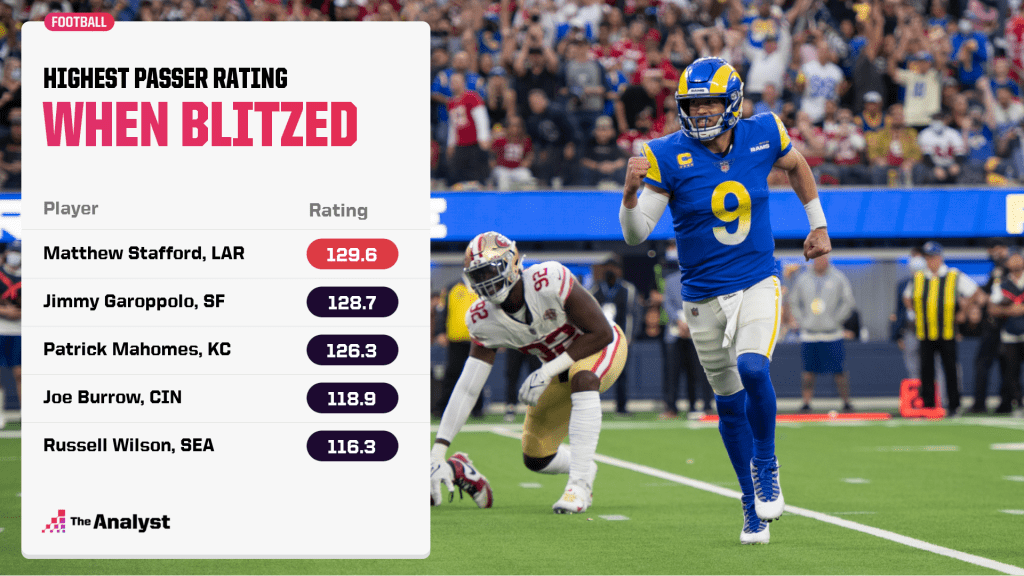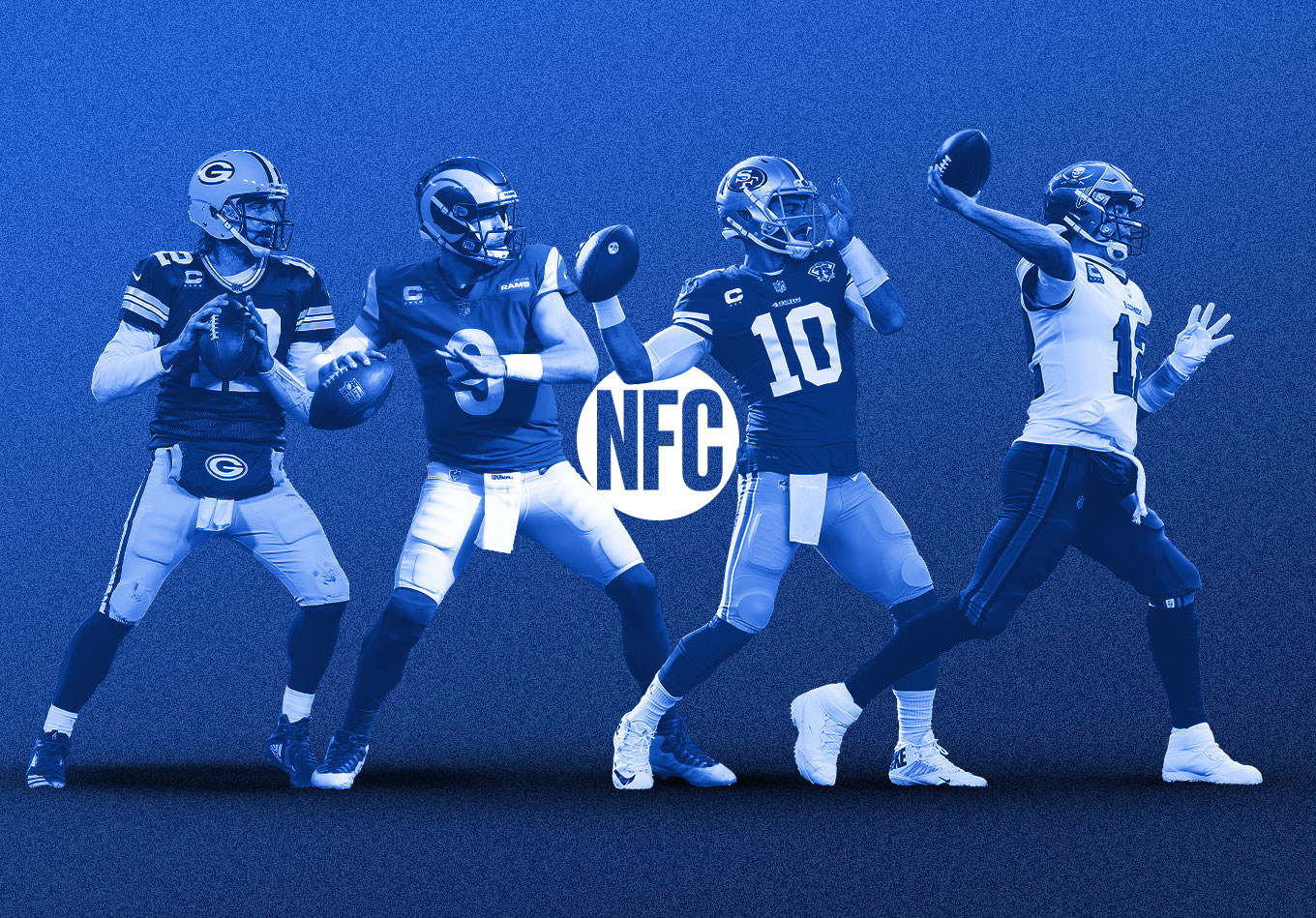The San Francisco 49ers have already bucked one trend during these NFL playoffs. They’ll now need to reverse another to keep their Super Bowl dreams alive.
San Francisco was the lone lower seed to advance during an opening-round weekend in which home teams largely dominated, with four of the six games won in lopsided fashion by the higher-seeded entrant. As a reward, the 49ers now get the unenviable assignment of a trip to frigid Lambeau Field to face Aaron Rodgers and the NFC’s top-seeded Green Bay Packers.
The Packers, the only team this season to go unbeaten at home, will have recent history on their side in addition to the advantage of playing in their own building. The NFC’s No. 1 seed has reached the conference championship game in eight of the last nine years, with the lone exception being the Dallas Cowboys’ 34-31 loss to Green Bay in 2016.
Green Bay also owns the league’s longest active home winning streak in regular-season play, a 13-game run dating back to November 2020.
That string of success excludes one very important matchup, however. As one may recall, the Packers were dealt a 31-26 defeat by Tampa Bay at Lambeau in last season’s NFC title game, a contest perhaps best remembered for coach Matt LaFleur’s questionable decision to kick a field goal with Green Bay down eight late in the fourth quarter.
The public doesn’t appear to be too swayed by either that result or the Packers having squeaked out a 30-28 win over these very same 49ers in San Francisco back in September. Green Bay currently stands as the largest betting favorite of this weekend’s four divisional round games at 5.5 points, a line that’s grown from its initial opening.
That’s not too surprising, as NFL wagering is extremely quarterback-driven, and most bettors would naturally side with a likely soon-to-be four-time NFL MVP in Rodgers over the at-times erratic Jimmy Garoppolo.
We don’t view the outcome as being so-clear cut, as our projection model has declared Saturday’s primetime showdown as a virtual dead-even game in terms of win probability. It’s also given San Francisco a greater chance of winning the Super Bowl heading into the divisional round.

The quarterback angle is also quite evident in the NFC’s other clash in which the Tampa Bay Buccaneers and seven-time Super Bowl champion Tom Brady rate as a three-point favorite over a Los Angeles Rams team whose signal-caller, Matthew Stafford, just earned the first playoff win of his 13-year career with last week’s 34-11 decimation of the Arizona Cardinals.
Our models take a divergent view here as well, suggesting that the wrong team may be favored when these two powerhouses take the field Sunday.
So, what exactly needs to happen to create an all-NFC West conference title game? Here are the keys to the game for both of these compelling and star-studded matchups:
San Francisco 49ers at Green Bay Packers (Saturday, 8:15 ET, FOX)
Line: Packers by 5.5
The Analyst Win Probability: Packers 50.2%
As mentioned above, Green Bay eked out a dramatic 30-28 victory in San Francisco back in Week 3 on Mason Crosby’s 51-yard field goal as time expired, with Rodgers driving the Pack into scoring range right after the Niners scored a go-ahead touchdown with 37 seconds remaining.
Rodgers was his usual sharp self that night, but it’s been anything but easy for both he and the Packers when they’ve squared off against San Francisco in the playoffs. The 38-year-old QB is 0-3 lifetime against the 49ers in postseason play, including a 37-20 road defeat in the 2019 NFC championship game in which San Francisco picked off Rodgers twice and bullied Green Bay’s defense with 285 rushing yards.
The 49ers may very well employ a run-heavy game plan this time as well, especially with the possibility of sub-zero wind chills being forecasted and Garoppolo now dealing with a slight sprain of his throwing shoulder in addition to a right thumb injury he’s been playing through.
Green Bay’s defense has had its hiccups at times against the run and can be vulnerable to big plays, having yielded gains of 10-plus yards on 13.7% of opponent rush attempts to rank 28th in the NFL. Still, it’s been solid overall in that area, sitting seventh in our EVE rankings in yards vs. expected on expected running plays.
The 49ers didn’t do much on the ground in this season’s previous meeting, generating just 67 yards on 21 attempts – their second-lowest rushing yardage total of 2021. They also played that game without impressive rookie Eli Mitchell, whose average of 2.33 yards after contact was the sixth highest of any running back with 100 or more rush attempts this season, and that came before Kyle Shanahan began extensively utilizing the uniquely dynamic Deebo Samuel as a ball-carrier.
What the 49ers Need to Do: Convert on Third Down and Inside the Red Zone
The 49ers’ 23-17 win in Dallas in last week’s wild-card round became way too close for comfort due to too many stalled drives by the offense, especially in the second half. San Francisco converted only two of six third-down opportunities after halftime and Garoppolo was woefully ineffective over the final two quarters, completing just 5 of 11 attempts for a measly 39 yards with an interception. The Niners’ lone second-half points, a dazzling 26-yard touchdown run by Samuel, were set up by a short field created by a defensive interception.
San Francisco did score on each of its four first-half possessions, but still left some points on the field after settling for long Robbie Gould field goals three times following three forays into Cowboys’ territory.
The 49ers don’t reach the red zone terribly often, as they ranked 20th in the NFL in trips inside the opponents’ 20 during the regular season, but they’re deadly when they get there with a touchdown percentage of 67.3% that was the best in the league. The Packers, meanwhile, were among the NFL’s worst red zone defenses with a 66.0% touchdown rate allowed that ranked 28th overall. The Packers surrendered a successful play on 51.7% of opponent snaps within the red zone, also near the bottom of the league at 26th overall.
A successful play is defined as anytime the offense gains 40% of yardage needed for a first down on first down, 50% of the yardage necessary for a first down on second down or converts on third or fourth down.
The 49ers had no trouble reaching the end zone in the first meeting, scoring on each of their four red-zone chances, and they converted a sharp 7 of 11 chances on third down.
They still didn’t win the game, however, as offensive inconsistency was an issue that night as well. San Francisco mustered a mere 25 total yards over its first three drives before Garoppolo caught fire late in the first half and stayed hot in the second, but the 49ers were at a 17-0 deficit by the time the passing game got on track. They briefly managed to dig their way out of that hole, but in the end those early missed opportunities proved costly.
The 49ers were able to (barely) get away with not playing a complete offensive game against the error-prone Cowboys. Chances are they’ll have a hard time overcoming prolonged spells of inefficiency against a Green Bay team that rarely beats itself with penalties and giveaways.
What the Packers Need to Do: Protect Aaron Rodgers
It’s silly to suggest that a quarterback with over 225 total NFL starts and 20 playoff starts, who has won three MVPs and a Super Bowl, can still get rattled. But a deeper dive indicates that despite Rodgers putting together yet another banner campaign in 2021, he can be taken off his game by a stiff pass rush.
Green Bay’s decorated quarterback owns an NFL-leading 79.3 completion percentage (min. 250 total attempts) this season when not facing pressure, and his pickable pass percentage of 1.81 with a clean pocket is also the best in the league.
Remarkably, Rodgers’ numbers when hit or hurried haven’t been even close to Pro Bowl level. His 60.7 well-thrown percentage under pressure was the second lowest of 29 quarterbacks with 100 or more pass attempts under duress this season, while his overall completion rate of 49.2% bettered only rookies Trevor Lawrence and Zach Wilson.

The 49ers can certainly bring the heat. Their overall win rate of 32.6% of one-on-one pass rush matchups was the highest in the NFL this season, with linemen Nick Bosa (48.6%) and Arik Armstead (46.8%) each earning particularly elite marks in that category. And the defense was sensational at harassing quarterbacks during the stretch run, producing 94 pressures on 180 opponent passing plays (52.2%) while generating 20 sacks over the regular season’s final five games.
That dominance carried over into the first round of the playoffs, even with Bosa sitting out the second half of the Dallas game with a concussion (he’s expected to be cleared for Saturday’s clash). San Francisco registered pressures on nearly half (24 of 49) the Cowboys’ passing plays, resulting in Dak Prescott taking five sacks and throwing a pivotal interception while compiling a subpar 60.0% well-thrown rate on those pressured plays.
The Packers were able to keep San Francisco’s potent pass rush reasonably in check in the Week 3 meeting, with the Niners recording a rather mild 13 pressures. And that was with left tackle David Bakhtiari still recovering from an ACL tear that sidelined him until the regular-season finale. Though the 2020 All-Pro has played only 27 snaps this season, he’s a potential difference-maker if anywhere near last year’s level, when he allowed the lowest opposing pressure rate of any tackle at 2.8%.
The 49ers aren’t a team that blitzes frequently, and Rodgers may be the best in the business at making defenses pay when they don’t bring extra attackers. His 113.3 passer rating in non-blitz settings is the highest of any signal-caller with 150 or more attempts in such situations this season, and he completed a crisp 78.6% (22 of 28) of his passes with a well-thrown percentage of 82.6 when San Francisco didn’t blitz in Week 3.
Another strong performance could be in store for this weekend, provided the Packers’ offensive line can keep Rodgers upright.
Los Angeles Rams at Tampa Bay Buccaneers (Sunday, 3 ET, NBC)
Line: Buccaneers by 3
The Analyst Win Probability: Rams 62%
That win probability number above likely will surprise many a viewer, but the Rams may be the most complete team of any this season. They rank second in offensive EVE, can routinely control both lines of scrimmage with a devastating pass rush and an offensive line that’s superb in pass protection, and possess the NFL’s premier defender in disruptor extraordinaire Aaron Donald as well as its most prolific receiver in Cooper Kupp.
They’re also the healthier of these two foes, as the Buccaneers have endured an ill-timed series of injuries to several key players in recent weeks. Top receiver Chris Godwin tore his ACL in late December, while an offensive line that’s been terrific in preserving the 44-year-old body of Tom Brady could conceivably be without two major pieces on Sunday after All-Pro right tackle Tristan Wirfs and center Ryan Jensen were both hurt in last week’s playoff win over the Philadelphia Eagles.
The Rams also own a win over Tampa Bay this season, a 34-30 victory in Los Angeles back in Week 3 in which Matthew Stafford outdueled Brady with a virtuoso 343-yard, four-touchdown display. Sean McVay’s troops will be entering Raymond James Stadium both confident and seemingly firing on all cylinders after barely breaking a sweat in last week’s trouncing of the Cardinals.
Tampa Bay did some manhandling of its own during Super Wild Card Weekend with a just-as-easy 31-15 rout of the Eagles, a game that was 31-0 after three quarters. And in case you weren’t aware, the Bucs happen to be the defending Super Bowl champions and have a quarterback that’s won a big game or two before.
What the Buccaneers Need to Do: Pressure Matthew Stafford
Tampa Bay did play the majority of its Week 3 loss to the Rams with a shorthanded secondary, as Sean Murphy-Bunting was on IR at the time and fellow starting corner Jamel Dean left the contest in the first quarter with a knee injury. The Bucs also barely laid a finger on Stafford the entire game, mustering a mere 10 pressures on L.A.’s 39 passing plays and giving that makeshift back end virtually no chance to keep up with Kupp and the rest of the Rams’ receivers, a group that had yet to include Odell Beckham Jr.
We mentioned last week that Stafford can be prone to mistakes when under a rush. His pickable pass percentage of 8.55 when pressured is the second highest of any quarterback with 100 or more attempts under duress, and his 65.8% well-thrown rate under pressure also lands below the league norm.
The Buccaneers also play a very aggressive style of defense, as only Miami blitzed at a higher frequency than Tampa’s 40.7% during the regular season. That’s a strategy that can be bad news against a team like the Rams if those extra attackers are successfully neutralized.
Stafford’s 129.6 passer rating when blitzed was the best of any team’s primary quarterback in the NFL this season, due in large part to his teammates’ excellence at beating coverage. Rams receivers have combined to win 39.2% of one-on-one matchups – the highest amount of any team. Kupp’s win rate of 58.9% was also the best in the league (min. 100 routes run), while Beckham (46.0%) has been well above average in that area as well.
As a result, Stafford had one of the highest open target percentages – how often the targeted receiver is open – when blitzed of any passer at 85.3.

The Bucs have to do a better job of disrupting the Rams’ timing than they did in the previous meeting, and there’s evidence to suggest they can with a pass rush that has improved over the course of the season. Tampa has recorded 20 or more pressures in a game eight times in 2021 when counting its playoff blowout, and five of those instances have come in its last nine outings.
None of those opponents can pass block like the Rams can, however. Los Angeles’ win rate of 80.3% of one-on-one matchups ranked second in the NFL, behind only the Buccaneers’ 82.6%.
What the Rams Need to Do: Avoid Turnovers
That sounds rather obvious, but it really may be just that simple, as the Rams are awfully tough to beat when they aren’t beating themselves.
Including last week’s trashing of Arizona, Los Angeles is a combined plus-11 in turnover margin over its 13 wins in 2021. In their five losses, the Rams have a turnover differential of minus-7 with nearly half (11 of 23) of their giveaways coming in those games. They’re 9-0 when turning it over one time or less and a mediocre 4-5 when having two or more.
The Buccaneers seem to have more areas that can be exploited, especially if Wirfs – who’s allowed the lowest opposing pressure rate of any tackle this season at 2.7% – can’t play or is hampered by the high ankle sprain he sustained a week ago. Tampa yielded a season-high 26 pressures to the Rams in Week 3 with its stout offensive line fully intact, and while that number was probably inflated due to the Bucs having to play behind for much of the game, they’re also the most air-oriented team in the league with passes accounting for nearly two-thirds of their total plays.
Tampa Bay’s primary advantage is that it’s been stingier with the ball than the Rams and a bit better at taking it away. Brady’s overall pickable pass percentage of 2.6 was the third lowest of any quarterback with 250 or more pass attempts this season, behind only Justin Herbert and Rodgers. Conversely, of the eight field generals whose teams will be playing this weekend, only Garoppolo has a higher pickable pass percentage than Stafford’s 4.43.
The Bucs’ chances of advancing to a second straight NFC title game would surely be enhanced if they win the turnover battle, as they’re 12-1 this season when committing one giveaway or fewer counting last week’s victory.
That one loss, by the way? You guessed it, came courtesy of the Rams.
Enjoy this? Subscribe to our mailing list to receive exclusive weekly content.
Kyle Cunningham-Rhoads and Greg Gifford contributed. Design by Matt Sisneros.
